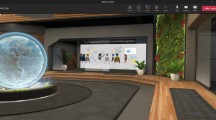Abstract
The amount of information technology in our everyday lives is increasing and getting more and more ambient in our daily environments. The environments are supposed to be intelligent, adaptive, intuitive and interactive in the future. User participation for future concept building is essential, but challenging, when designing appliances that might be unfamiliar in their appearance, functionality and impressiveness compared to the user’s current everyday life. New allocated methods and viewpoints are needed for user experience design and evaluation of intelligent environments to build systems that naturally support the users in their daily life. We present interactive scenario building together with potential users (including role-playing, drama and improvisational aspects) as one promising tool for early concept definition phase.





Similar content being viewed by others
References
Iain Banks: science fiction. Available at http://www.iainbanks.net/sf.htm
Ray Bradbury. Available at http://www.raybradbury.com/
Philip K Dick. Available at http://www.philipkdick.com/
Bush V (1945) As we may think. Athlantic Monthly 176(1):101–108
MIT Project Oxygen: overview. Available at http://oxygen.lcs.mit.edu/Overview.html
Weiser M (1991) The computer for the twenty-first century. Sci Am 265(3):94–104
Weiser M, Brown JS (1996) The coming age of calm technology. In: Denning P, Metcalfe R (eds) Beyond calculation: the next fifty years of computing. Springer, Berlin Heidelberg New York, pp 75–86
Scholtz J, Arnstein L, Kim M, Kindberg T, Consolvo S (2002). User-centered evaluations of ubicomp applications. Technical report, Intel Research, IRS-TR-02-006
Abowd G, Mynatt E (2000) Charting past, present, and future research in ubiquitous computing. ACM Trans Comput Hum Interact 7(1):29–58
Abowd GD, Mynatt ED, Rodden T (2002) The human experience. Pervasive Comput 1(1):48–57
Rentto K, Korhonen I, Väätänen A, Pekkarinen L, Tuomisto T, Cluitmans L, Lappalainen R (2003) Users’ preferences for ubiquitous computing applications at home. In: Aarts E, Collier R, van Loenen E, Ruyter Bd (eds) Proceedings of the 1st European symposium on ambient intelligence (EUSAI 2003), Veldhoven, The Netherlands, 3–4 November 2003. Lecture Notes in Computer Science, vol. 2875. Springer, Berlin Heidelberg New York, pp 384–393
Norros L, Kaasinen E, Plom PJ, Rämä P (2003) Human-technology interaction research and design. VTT Roadmap, VTT Tiedotteita, research notes 2220
ISO 13407 (1999) Human-centred design processes for interactive systems. The International Organization for Standardization
Hughes J, King V, Rodden T, Anderson H (1995) The role of ethnography in interactive systems design. ACM Interact 2(2):56–65
Ehn P (1989) Work-oriented design of computer artifacts. Erlbaum, New Jersey
Beyer H, Holzblatt K (1998) Contextual design: defining customer-centered systems. Morgan Kaufmann, San Francisco
van Willigen J (1993) Applied anthropology: an introduction. Bergin & Garvey, Westport
Grudin J, Pruitt J (2002) Personas, participatory design and product development: an infrastructure for engagement. In: Proceedings of the 7th biennial particpatory design conference (PDC 2002), Malmö, Sweden, June 2002, pp 144–161
Clement A, van den Besselaar P (1993) A retrospective look at PD projects. Commun ACM 36(6):29–37
Howard S, Carroll J, Murphy J, Peck J (2002) Using ‘endowed props’ in scenario-based design. In: Proceedings of the 2nd Nordic conference on human-computer interaction, Aarhus, Denmark, October 2002
Iacucci G, Kuutti K, Ranta M (2000) On the move with a magic thing: role playing in concept design of mobile services and devices. In: Proceedings of the ACM conference on designing interactive systems (DIS’00), New York City, August 2000
Iacucci G, Kuutti K (2002) Everyday life as a stage in creating and performing scenarios for wireless devices. Personal Ubiquitous Comput 6:299–306
Brandt E, Grunnet C (2000) Evoking the future: drama and props in user centered design. In: Cherkasky T, Greenbaum J, Mambrey P (eds) Proceedings of the 6th biennial participatory design conference (PDC 2000), New York, November/December 2000, pp 11–20
Oulasvirta A, Kurvinen E, Kankainen T (2003) Understanding contexts by being there: case studies in bodystorming. Personal Ubiquitous Comput 7(5):125–134
Buchenau M, Fulton Suri J (2000) Experience prototyping. In: Proceedings of the ACM conference on designing interactive system (DIS’00), New York City, August 2000
Lerdahl E (2001) Staging for creative collaboration in design teams. Models, tools and methods. Doctoral thesis, Department of Product Design Engineering, NTNU, Trondheim, IPD report 11
Seland G (2002) Developing ideas for future electronic patient record systems through drama improvisation. Department of Computer and Information Science, Norwegian University of Science and Technology, Trondheim. Available at http://www.idi.ntnu.no/~grysl/Workshop.pdf
Dolonen J, Mørch A, Åsand HR (2003) Learning and knowledge building at work. In: Proceedings of the 2nd European conference on computer-supported collaborative learning (CSCL 2003), Bergen, Norway, June 2003, pp 68–71
Kolu S, Mehto K, Pennanen M, Tiihinen J, Vesanen R (2003) Käyttöliittymä elämään—ikkunoita draaman ja teknologian kohtaamiseen (User interface to life–windows for incidence of drama and technology). Helsingin ammattikorkeakoulu Stadia, Yliopistopaino, Helsinki
Johnstone K (1979) Impro: improvisation and theater. Methuen, London
Nomadic Media. Available at http://www.extra.research.philips.com/euprojects/nomadic-media/index.htm
Acknowledgements
We would like to thank all of the participants and projects that gave input to the test cases. The study has been funded in part by the national resources of the Nomadic Media project [31].
Author information
Authors and Affiliations
Corresponding author
Rights and permissions
About this article
Cite this article
Strömberg, H., Pirttilä, V. & Ikonen, V. Interactive scenarios—building ubiquitous computing concepts in the spirit of participatory design. Pers Ubiquit Comput 8, 200–207 (2004). https://doi.org/10.1007/s00779-004-0278-7
Received:
Accepted:
Published:
Issue Date:
DOI: https://doi.org/10.1007/s00779-004-0278-7




